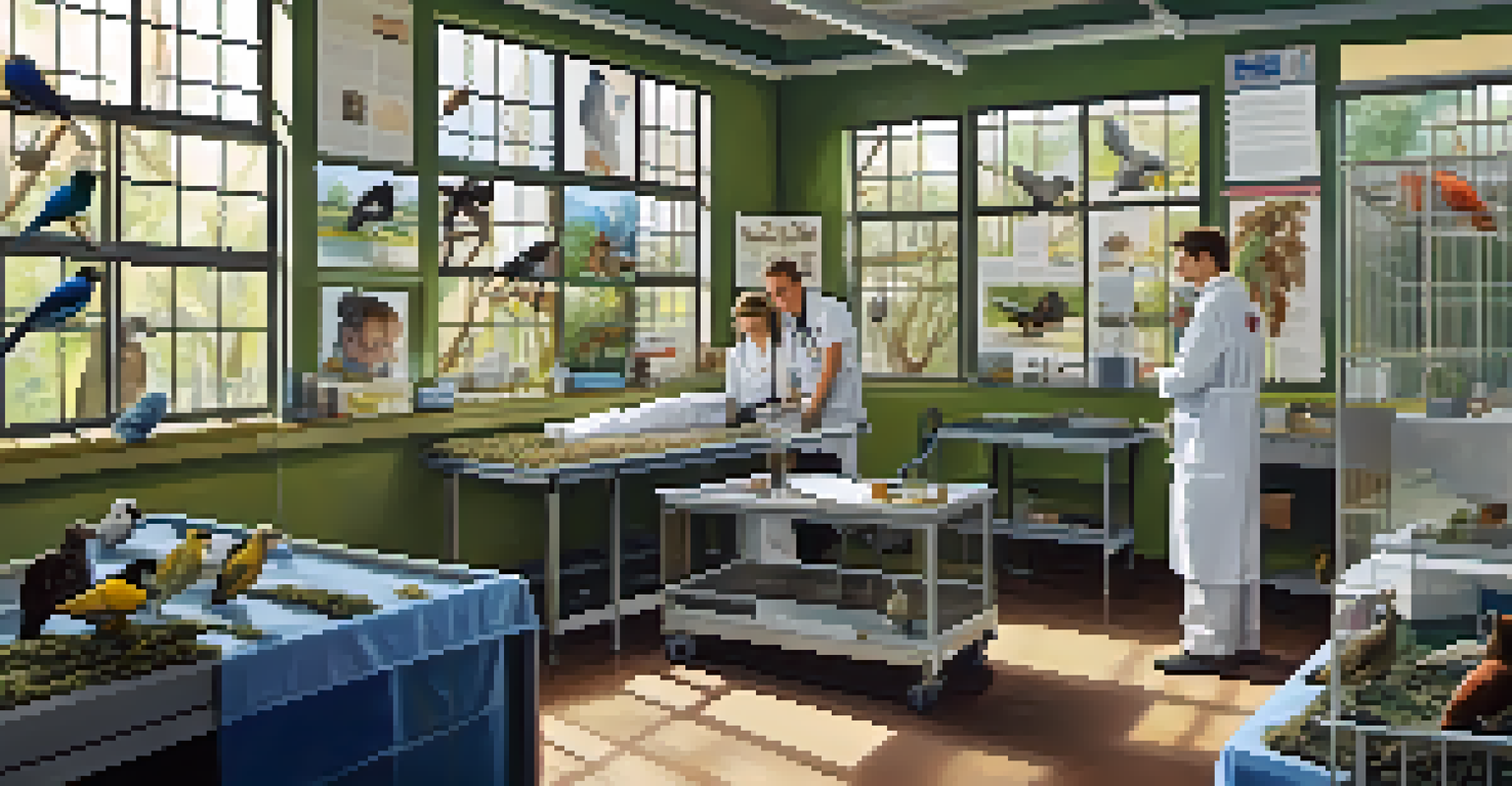Successful Urban Wildlife Rehabilitation Programs in Los Angeles

Understanding Urban Wildlife Challenges in Los Angeles
Los Angeles is a sprawling metropolis that offers a unique blend of urban life and wildlife. With its diverse ecosystems, animals often find themselves living in unexpected places, from parks to backyards. This proximity to humans can lead to challenges, including habitat loss and human-wildlife conflicts, prompting the need for effective rehabilitation programs.
The greatness of a nation and its moral progress can be judged by the way its animals are treated.
Many species, like raccoons and opossums, adapt well to city living, but this can result in increased encounters with people. These interactions can sometimes be harmful, both for the animals and the residents. Urban wildlife rehabilitation programs play a vital role in addressing these issues, helping to educate the community while ensuring the animals receive the care they need.
By understanding the challenges that urban wildlife face, we can better appreciate the importance of rehabilitation programs. These initiatives not only help to restore individual animals to health but also contribute to a more harmonious coexistence between humans and wildlife in the city.
Key Players in LA's Wildlife Rehabilitation Scene
In Los Angeles, several organizations are at the forefront of wildlife rehabilitation. Groups like the California Wildlife Center and the Wildlife Care of Southern California have established themselves as essential resources for injured or orphaned animals. Their dedicated teams of professionals and volunteers work tirelessly to rescue, rehabilitate, and release wildlife back into their natural habitats.

These organizations often collaborate with local animal control and law enforcement agencies to provide support during wildlife emergencies. Their expertise ensures that animals receive appropriate medical care, while also addressing public safety concerns. This cooperative approach highlights the community's commitment to wildlife welfare.
Importance of Wildlife Rehabilitation
Urban wildlife rehabilitation programs in Los Angeles play a crucial role in addressing human-wildlife conflicts and restoring healthy ecosystems.
Moreover, these organizations often provide valuable educational resources to the public. By raising awareness about local wildlife and the challenges they face, they empower residents to take action and support wildlife conservation efforts.
Innovative Techniques in Wildlife Rehabilitation
Wildlife rehabilitation is not just about providing immediate care; it also involves using innovative techniques to ensure the best outcomes for animals. Many programs in Los Angeles have adopted advanced medical practices and rehabilitation methods tailored to the unique challenges of urban wildlife. For instance, they may utilize specialized facilities that mimic natural habitats to help animals recover more effectively.
In every walk with nature one receives far more than he seeks.
In addition to medical care, behavioral rehabilitation is a crucial aspect of the process. This may include training animals to recognize safe environments or teaching them survival skills before their release. Such techniques are designed to enhance their chances of thriving in the wild.
The integration of technology also plays a role in these programs. From tracking devices to monitor released animals to using social media for awareness campaigns, these tools help improve the overall success of wildlife rehabilitation efforts.
Community Involvement in Wildlife Rehabilitation
Community involvement is a cornerstone of successful wildlife rehabilitation programs in Los Angeles. Many organizations rely on volunteers for various tasks, from rescuing animals to educating the public. This active participation fosters a sense of responsibility and connection between residents and the wildlife that shares their environment.
Workshops and training sessions are often held to teach community members how to safely assist injured wildlife. This not only empowers individuals but also creates a network of informed citizens who can respond to wildlife emergencies. Such grassroots efforts can make a significant difference in the lives of animals in distress.
Community Engagement is Vital
Active community involvement through volunteering and education fosters a sense of responsibility and enhances the success of wildlife rehabilitation efforts.
Additionally, community events like fundraising drives and awareness campaigns help raise crucial funds for rehabilitation programs. These efforts demonstrate the collective commitment to wildlife conservation and highlight the importance of collaboration between organizations and the public.
Success Stories from LA's Wildlife Rehabilitation Efforts
One of the most heartwarming aspects of wildlife rehabilitation in Los Angeles is the success stories that emerge from these programs. For example, the rescue and rehabilitation of a young owl that was found injured in a residential area showcases the dedication of local organizations. After receiving medical treatment and care, the owl was successfully released back into the wild, much to the delight of the community.
Another inspiring story involves a family of raccoons that were orphaned after their mother was struck by a vehicle. Thanks to the efforts of a local wildlife center, the young raccoons were nurtured and eventually released together, allowing them to support one another in their new lives. These stories not only highlight the impact of rehabilitation efforts but also resonate with the community, fostering a sense of shared success.
Such success stories are vital for raising awareness about the importance of wildlife rehabilitation. They serve as reminders of the positive outcomes that can result from community involvement and dedicated care, inspiring others to support these essential programs.
The Role of Education in Wildlife Rehabilitation
Education is a fundamental element of wildlife rehabilitation programs in Los Angeles. Organizations strive to inform the public about local wildlife, their habitats, and the challenges they face. By providing resources, workshops, and outreach programs, they help foster a more informed community that understands the importance of coexistence with wildlife.
Schools often partner with rehabilitation organizations to introduce students to the principles of wildlife conservation. Through hands-on experiences and educational materials, children can develop a lifelong appreciation for animals and the environment. This early exposure can inspire future generations to advocate for wildlife protection.
Challenges in Urban Wildlife Care
Limited funding and ongoing urbanization pose significant challenges for wildlife rehabilitation organizations in Los Angeles.
Moreover, social media platforms and community events are utilized to spread awareness about wildlife issues. Engaging content and interactive campaigns encourage residents to take an active role in wildlife conservation, further solidifying the community's commitment to protecting their urban wildlife.
Challenges Facing Urban Wildlife Rehabilitation in LA
Despite the successes, urban wildlife rehabilitation in Los Angeles is not without its challenges. One significant issue is the limited funding that many programs face, which can restrict their ability to provide comprehensive care and outreach. As the demand for wildlife rehabilitation grows, securing financial support remains a priority for these organizations.
Additionally, the ongoing urbanization of Los Angeles poses threats to wildlife habitats. As new developments emerge, animals are often displaced, leading to increased calls for rescue and rehabilitation. This creates a cycle where wildlife programs must continually adapt to meet the needs of both the animals and the community.

Finally, public misconceptions about wildlife can hinder rehabilitation efforts. Some residents may view certain species as pests rather than integral parts of the ecosystem. Education and outreach are crucial in addressing these misconceptions, helping to foster a more compassionate understanding of urban wildlife.